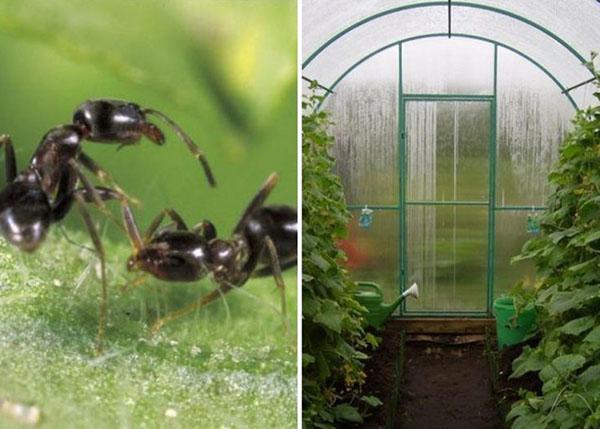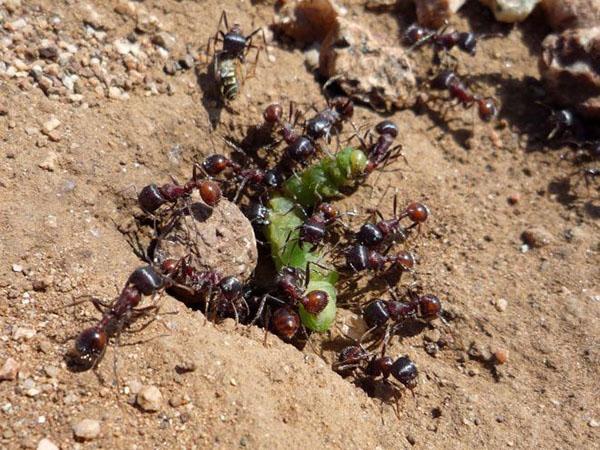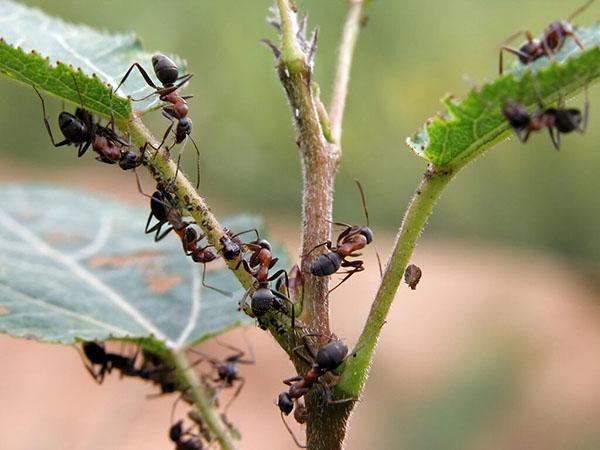How to get rid of ants in a greenhouse: effective methods and advice from experienced gardeners
 The appearance of insects in greenhouses can cause a significant decrease in yield. This publication will tell you how to get rid of ants in a greenhouse using folk methods and using proven insecticides.
The appearance of insects in greenhouses can cause a significant decrease in yield. This publication will tell you how to get rid of ants in a greenhouse using folk methods and using proven insecticides.
The benefits and harms of ants


Despite the obvious benefits, the proximity to these hardworking insects in the greenhouse brings a lot of harm to crops:
- An increase in soil acidity, which is detrimental to some garden crops.
- Destruction of young shoots and fruits of plants with a high fructose content.
- Suppression of the root system of seedlings, which suffers from the construction of an anthill.
- The increased incidence of greenhouse plants, because insects are carriers of various diseases.
In addition, sooner or later a colony of aphids will appear in a greenhouse with an anthill. These insects, safe for humans, in a short time suck the juices from plants, which leads to their deformation and death. The ant habitat is usually not limited to the greenhouse. That is why they can bring in weed seeds from the outside, which multiply rapidly in a favorable microclimate of the greenhouse.
Greenhouse ant control methods
 The reasons for the appearance of ants on greenhouses are very commonplace: they are attracted by the smell of organic matter and the temperature and humidity characteristics of the greenhouse. A greenhouse for ants is an ideal place to live, providing them with sources of water, food and all the opportunities to increase their population. Most often, black "garden" and red "forest" ants appear in greenhouses. Despite the different habitat, both the first and the second feed on roots, seeds, young shoots, sweet fruits of vegetable crops. How to get rid of ants in a greenhouse if it is impossible to eliminate the natural cause of their appearance?
The reasons for the appearance of ants on greenhouses are very commonplace: they are attracted by the smell of organic matter and the temperature and humidity characteristics of the greenhouse. A greenhouse for ants is an ideal place to live, providing them with sources of water, food and all the opportunities to increase their population. Most often, black "garden" and red "forest" ants appear in greenhouses. Despite the different habitat, both the first and the second feed on roots, seeds, young shoots, sweet fruits of vegetable crops. How to get rid of ants in a greenhouse if it is impossible to eliminate the natural cause of their appearance?
Gardeners practice a lot of effective ways to combat these insects, among which should be highlighted:
- Using folk remedies.
- The use of insecticides and various chemicals.
They all have their own advantages and disadvantages. To figure out how to quickly and safely get rid of ants in a greenhouse, we will consider each method in more detail.
Folk remedies

The methods of struggle can be conditionally divided into methods:
- Physical impacts aimed at reducing the population, removing insects' comfortable habitats or destroying the uterus.
- Use of insect repellents.
An effective remedy for ants in a greenhouse is potatoes, since the digestive tract of insects is not able to digest starch. To destroy the population, it is enough to chop the potato peelings and spread them in the immediate vicinity of the anthill. A similar effect is caused by millet groats. Insects are killed by eating raw millet.
 The simplest and most effective way to physically destroy insects is to treat the anthill with boiling water. Jam, honey, or sugar syrup can be used as insect bait. A jar with such contents, left for several days near the anthill, will be filled with insects. To destroy them, you just need to fill the container with boiling water.
The simplest and most effective way to physically destroy insects is to treat the anthill with boiling water. Jam, honey, or sugar syrup can be used as insect bait. A jar with such contents, left for several days near the anthill, will be filled with insects. To destroy them, you just need to fill the container with boiling water.
The most popular greenhouse folk remedy for ants is garlic, which must be chopped and mixed with sawdust. The resulting composition must be sprinkled on the ant heap. An aqueous solution of garlic also works very well: 1 chopped head per 10 liters of water. Another good way to fight ants is to spray their habitats with a solution of kerosene: only 2 tablespoons of this product are needed for a bucket of water. It is necessary to water the anthill and places where insects accumulate with solutions.
The smell of mustard is known to effectively repel insects. It is simple to use it: the paths, aisles and all the wooden elements of the greenhouse structure are sprinkled with dry powder. This method is inexpensive and effective, but only with a small population of ants in the greenhouse.
What plants scare off ants
 Planting plants, the smell of which is poorly tolerated by insects, is popular with domestic greenhouse owners. Practice has shown that insects never build their houses near plantings of mint and wormwood. If you have a question before you: how to get rid of ants with wings in a greenhouse without resorting to chemical planting treatments.
Planting plants, the smell of which is poorly tolerated by insects, is popular with domestic greenhouse owners. Practice has shown that insects never build their houses near plantings of mint and wormwood. If you have a question before you: how to get rid of ants with wings in a greenhouse without resorting to chemical planting treatments.
The easiest option is to plant insect repellent plants near garden crops:
- mint;
- lemon balm;
- lavender;
- rosemary;
- marigold.
Planting these plants in the greenhouse will protect the cultivated plants from ants. According to experienced gardeners, in order to remove ants from the greenhouse, it is enough to simply spread these plants in places where insects accumulate.
How to cultivate the land from ants in a greenhouse

Tillage methods:
- Pre-planting soil preparation involves processing with an aqueous solution of soda and linseed oil. To create a solution, you will need: 1 liter of water, 5 g of soda and 30 ml of oil.
- For the destruction of insects, the anthill and the places of accumulation of parasites are filled with boric acid.
- Ammonia is an excellent means of controlling the ant population in greenhouses. For 5 liters of water, 2 tablespoons of ammonia are required. The solution must be carefully poured over the ant heap.
How to poison ants in a greenhouse
 Among the many folk remedies for insect control in greenhouses, boric acid is highly effective.
Among the many folk remedies for insect control in greenhouses, boric acid is highly effective.
Boric acid is a specific chemical preparation, large doses of which, if ingested by animals and humans, can lead to serious poisoning. Take precautions when using boric acid.
Boric acid can be used to make effective poisonous baits. We offer one of the most popular recipes, which is very simple to prepare:
- ¼ a tablespoon of boric acid to dissolve in 1 glass of water.
- Add 4 tablespoons of sugar to the solution, jam or honey.
The contents should be distributed in small containers and placed in the greenhouse. The second variant of the poisoned bait for fighting ants is meat balls with the addition of boric acid, which must be laid out in the greenhouse. The recipe is simple: add 1 teaspoon of boric acid to 100 g of minced meat.
As practice has shown, the best way to prevent the appearance of ants in greenhouses is to annually dig the soil in the greenhouse in order to damage the anthill, destroy the larvae and egg-laying sites, and then add wood ash, lime and baking soda to the soil.
How to get rid of ants in a greenhouse with industrial pesticides
 Despite their popularity, traditional methods are not always effective, especially when dealing with large populations of ants.In this case, experienced gardeners go to extreme measures - the use of insecticides - specialized chemicals to combat insect pests.
Despite their popularity, traditional methods are not always effective, especially when dealing with large populations of ants.In this case, experienced gardeners go to extreme measures - the use of insecticides - specialized chemicals to combat insect pests.
The most effective are:
- "Thunder". It is necessary to remove the upper part of the ant heap, sprinkle the contents of the bag in its place, which should be sprinkled with earth. According to the manufacturer, the ant population will die within two to three days.
- "Muratsid", "Anteater", "Muravyin". Diazinon, which is deadly to insects, is used as the active substance of these drugs.
On sale you can also find a very large assortment of garden ants control products.
All chemicals are highly toxic pesticides that cause poisoning not only of insects, but also of humans. When working with insecticides, take precautions: protect the respiratory system, mucous membranes of the nose and eyes, and skin from contact with chemicals.
Tips from experienced gardeners
 If you see ants on peppers in your greenhouse, get ready to fight aphids. The insects themselves practically do not use pepper for food, but they use plants as a ground for grazing aphids. The gardener will have to fight with two enemies at the same time: ants and aphids. The most effective way is to use complex insecticides that have a detrimental effect on pests.
If you see ants on peppers in your greenhouse, get ready to fight aphids. The insects themselves practically do not use pepper for food, but they use plants as a ground for grazing aphids. The gardener will have to fight with two enemies at the same time: ants and aphids. The most effective way is to use complex insecticides that have a detrimental effect on pests.
If ants appear in a greenhouse with tomatoes, then an aqueous solution of vinegar, in a 1: 1 ratio, will help. It should be applied to the paths between the beds, as well as to the pegs and trellis posts that hold the crops. Ants cannot stand the smell of vinegar and after several treatments they will leave the greenhouse with tomatoes forever. This procedure is also recommended as a preventive measure against the appearance of ants in the greenhouse. Preventive treatments should be carried out every 7-10 days.
What to do with ants in cucumber seedlings? Indeed, ants feed on seeds and cucumber seedlings. The best way to get rid of insects is by using poison baits. The most effective and safest option is to mix brewer's yeast with honey, sugar, or jam.
An interesting article, only the methods and means of fighting ants are already a little outdated. It has long been invented and used with great success microencapsulated ant preparations, for example the Israeli master 250, which are completely safe for humans and animals. And also for the plants themselves. It is easily washed off the fruits with plain water and is not absorbed into the plant itself or its fruits. But it perfectly destroys the entire insect population. Once processed - the whole season or even two ants are not in sight. I tried it myself. And boiling water, potatoes and millet are, of course, all very eco-friendly, but other pests will also crawl onto this organic matter.